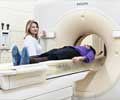As early as one week after beginning treatment for brain tumors, a new imaging analysis method was able to predict which patients would live longer, researchers from the University of Michigan Comprehensive Cancer Center have found.
The method uses a standard magnetic resonance imaging, or MRI, protocol to monitor changes over time in tumor blood volume within individual voxels of the image, rather than a composite view of average change within the tumor. This parametric response map allowed researchers to see specific areas in which tumor blood volume increased or decreased, that may have canceled each other out when looking at the changes as an average.Results of the study appear in the advance online edition of Nature Medicine.
"What we have potentially is a generalized analytical approach that we can use to quantify treatment intervention in patients," says study author Brian Ross, Ph.D., professor of radiology and biological chemistry at the U-M Medical School and co-director of the Molecular Imaging Program at the U-M Comprehensive Cancer Center.
The researchers looked at 44 people with high-grade glioma, a type of brain tumor, who were treated with chemotherapy and radiation. Each participant underwent MRIs before treatment, and one week and three weeks after starting treatment. The researchers then looked at the relative cerebral blood volume and the relative cerebral blood flow of the tumor to analyze voxel-wise changes among the serial scans.
Looking at standard comparisons using averages, the scans indicated no change one week and three weeks into treatment. But, using the parametric response map approach, the researchers were able to show changes in the tumor's blood volume and blood flow after one week that corresponded to the patient's overall survival.
"We're seeing treatment response earlier into the treatment, and responses that couldn't be detected at all looking at average changes. We could detect this after just one week, which is amazing for brain tumors," says study author Craig Galbán, Ph.D., assistant professor of radiology at the U-M Medical School.
Advertisement
The researchers believe this approach might also be useful with other imaging techniques such as PET and CT scans.
Advertisement
SRM














